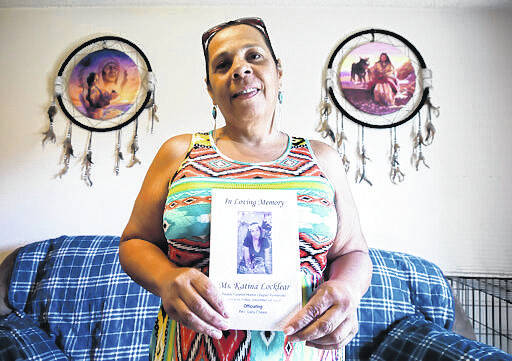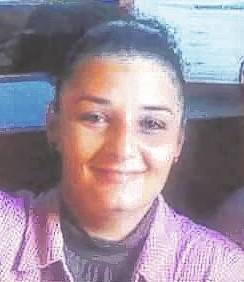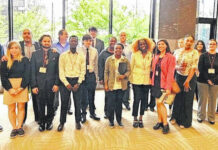PEMBROKE (AP) — Katina Locklear died at end of a dirt road, her body abandoned next to a bug-infested drainage ditch where frogs jump past any intruder.
To hear her sister tell it, Katina had a soft spot for the homeless men who camped there in rural Pembroke, where the ground is strewn with beer bottles. She knew all the “street people” in Pembroke; she once had her own drug problems before getting cleaned up.
On the day she died, Jane Jacobs said, her 46-year-old sister had gone to bring those people food — five days before last Christmas. But somebody thought she’d stolen money. When police found her later, Jacobs said, Katina had been gang-raped and stabbed 14 times. She left four children and two grandchildren behind.
“She got killed before she could fight back,” said Jacobs, who lives in Wilmington. “We’re Tuscarora. We fight. We don’t go down easy.”
As a Tuscarora, a tribe with centuries-old roots in North Carolina, Katina Locklear represents a group that’s gaining nationwide attention: missing and murdered American Indian women.
On May 5, Gov. Roy Cooper declared a day of awareness for such crimes in North Carolina, which is home to roughly 122,000 American Indians — the largest population east of the Mississippi River.
Of all its tribes, only one — the Cherokee — is recognized by the U.S. government, living largely on a reservation in the Smoky Mountains. The others are scattered across the state and assimilated into their black and white neighbors’ cultures, where they struggle for identity and a brighter economic future.
In his proclamation, Cooper cited studies showing that American Indian women are more than three times as vulnerable to violent crimes and twice as likely to be raped as women of other races. In North Carolina, roughly 90 cases of missing or murdered indigenous women — dating back to 1994 — remain unsolved.
Nationwide, one 2008 study funded by the U.S. Department of Justice shows some counties posting an even more grim murder rate for American Indians: up to 10 times as high. In coming weeks, Crystal Red Bear Cavalier-Keck, an activist in Alamance County and tribal member of the Occaneechi Band of the Saponi Nation, will brief N.C. Attorney General Josh Stein’s office on issues specific to law enforcement and indigenous people.
Cavalier-Keck says no reliable numbers of total American Indian victims exist. Legislation is needed to create an accurate and updated database because many of the numbers that are used come from individual news reports, she said.
“It’s a native issue, but there are all kinds of people who want to do right,” she said. “If we can just get more people talking about this.”
But law enforcement statewide could benefit from some cultural awareness, said Jason Crazy Bear Campos Keck, her husband and a member of the Louisiana band of Choctaw. It’s not enough just to know that American Indians exist, he said, but essential to get a sense of how a tribe operates.
Within native communities, which tend to be lower-income, there is an ancient tendency to handle problems within the tribe rather than seek outside aid. As a result, many crimes go unreported.
“We are looked at as easy prey for a predator because of our economy,” Keck said. “We don’t traditionally trust law enforcement for help. Native Americans are looked at as exotics by these criminals.”
What stings most, said Jacobs of the Tuscarora, is the feeling of neglect.
Robeson County, where Katina Locklear lived, has the highest crime rate in the state and a population that is 40 percent American Indian. In 2017, three Lumberton women were found dead within four blocks of each other — two of the victims Lumbee.
Jacobs said most people in North Carolina are surprised to learn American Indians still exist, and their deaths rarely garner any attention. Her sister’s homicide got four paragraphs on local television and seven paragraphs in the local newspaper — and that was a week later, when two Pembroke men were charged with murder.
“If you see a Caucasian that’s missing and the way my sister was brutalized, it would be national attention,” Jacobs said. “It’d be all over every news form that there was. When it’s one of us nobody cares.”
If the growing attention to American Indian women has a high-profile victim, it is Faith Hedgepeth.
A sophomore at UNC-Chapel Hill, she grew up in a community of the Haliwa-Saponi along the Warren-Halifax border, where she knew practically all 2,500 members of the rural tribe, The News & Observer reported in 2012.
She came from a world with scant employment opportunity for young people: only a Dollar General was nearby. When a scholarship for advanced minority students sent her to Chapel Hill, Hedgepeth dreamed of becoming a pediatrician but took part-time jobs to get grocery and gas money, working for a time at a Red Robin near the Durham border.
When she died in her off-campus apartment in September 2012, Hedgepeth had been struggling to stay afloat academically and financially. Then on a Saturday night, she finished studying and went out to a Chapel Hill dance club, where voicemail messages obtained later revealed that she had been in a heated discussion with several men.
Her roommate and a friend found her unresponsive in her room the next morning. Chapel Hill police now believe she had been bludgeoned to death with a rum bottle. After seven years, thousands of interviews and more than 100 DNA samples, the case remains notoriously unsolved.
Since then, powwows have celebrated Hedgepeth’s life and rallies on campus have tried to shine light on her death. Her father, Roland Hedgepeth, said he had no idea native women were targets until well after Faith died.
“To be honest with you,” he said, “it’s the fact that native people are just kind of almost disavowed, as though we don’t exist to some point, to where we don’t matter, or native people are expendable. And I think that probably is right in line with it that so many go unsolved.”
In April of 2017, Lumberton police discovered Rhonda Jones upside-down and naked inside a trash can. A neighbor noticed a leg sticking out from under the lid. Her body had decomposed and was partially covered in trash.
A member of the Lumbee tribe, Jones had drug problems, her mother, Sheila Price, said. But despite those problems, she took care of her five children in a part of Lumberton that has since become infamous, inspiring international news articles on the possibility of a serial killer.
Five women either remain missing-person cases or unsolved murders since 2017 in roughly the same part of Lumberton, the seat of Robeson County, according to the FBI. Three of them, including Jones, were Lumbee. One of them, Cynthia Jacobs, had a history of prostitution before she disappeared. Another, Megan Oxendine, may have known about the other killings, said her mother, according to ABC 15 in Myrtle Beach.
Jones’ mother said she believes the cases have dragged on agonizingly slowly because the women were involved with crime and came from native backgrounds. She and other families complained that police took too long to submit rape kits for testing, and Lumberton Police Chief Michael McNeill later agreed, the Myrtle Beach station reported.
Getting autopsy results for her daughter, which were inconclusive, took more than a year. The medical examiners in Chapel Hill said they could not rule out asphyxiation but decomposition complicated their conclusions.
“I don’t even know how my child died,” Price said.
In May, native organizers led a rally at the Capitol in Raleigh, finding new media attention for these deaths. In July, activists for murdered and missing indigenous women marched at the annual Lumbee Homecoming Parade in Pembroke.
These are small but important steps, said Cavalier-Keck, for native women coming out of a life spent in shadows.
Meanwhile, the two men charged with murder in Katina Locklear’s death await trial. According to court records in Robeson County, both of them are American Indians.
“Not only do others not respect our lives, we don’t respect our lives,” said Jacobs, her sister. “We kill each other.”
In the patch of woods where police found Locklear, her daughter Miranda Bledsoe has placed a small memorial — a patch of purple balloons and plastic Easter eggs that stand out against the dirt and weeds.
In the months since Katina died, much of the memorial has blown away.

Katina Locklear’s sister, Jane Jacobs, stands in her Wilmington home holding the program from her sister’s December 2018 funeral. Locklear, a Tuscarora woman, was a 46-year-old mother of four and grandmother of two. She was raped and murdered in a patch of woods in Pembroke after a dispute over missing money, which was later found elsewhere.











